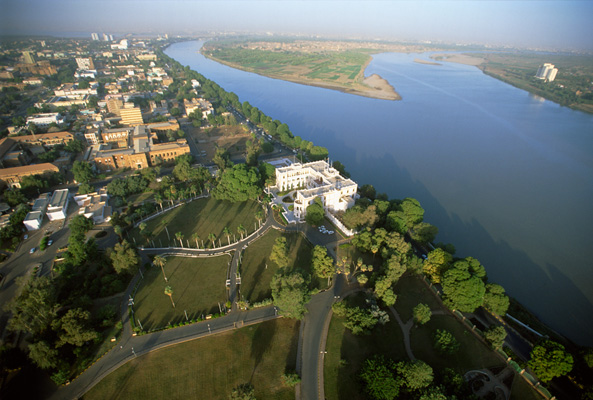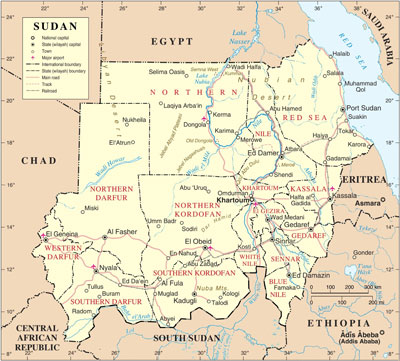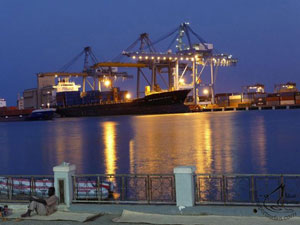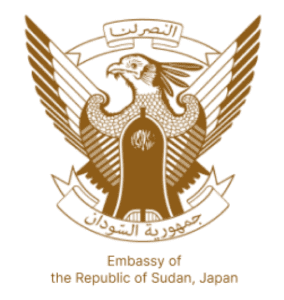KHARTOUM CITY

Capital
Khartoum town lies along the left bank of the Blue Nile, and forms a huge triangle. Its vertex at the confluence of then two Niles, the White Nile on its west side and the Blue Nile on its east and the base bordering Gezira State some 30 K. southward. It is situated on latitude 15 36 N, and longitude 31 32 E, and it is 1352 ft. above sea level. Its population has grown to over 5 million people. Khartoum, together with the two cities, Omdurman and Khartoum North (Bahri), these cities jointly called the tri-capital, constitute the National Capital of the republic of Sudan.


Location
Sudan lies within the African tropical zone. Its climate varies from equatorial in its most southern parts, Savanna in the centre, and continental in the northern parts. The period from March to June is the hottest part of the year with temperatures of up to 42 degrees Celsius during the day and 27 degrees Celsius at night. But the temperature gradually begins to decline when it starts raining from July to October. From November to February, which is the best time of the year in the country, temperatures range between 16 to 30 degrees Celsius with beautiful warm sunshine during daytime hours.




















Climate of Khartoum
The climate is mainly tropical. During summer (March – June), the temperature is quite high, with an average temperature of 38 C, with May as being the hottest month of the year. Autumn starts from mid-July and ends on September, with a total rainfall of 167 mm; it is characterized by abundance of sandstorms. Winter starts on October and lasts up to March, it is endowed with a beautiful to moderate, dry and healthy weather, the average temperature in Winter is 24 C, the ideal time for foreigners to visit Khartoum and enjoy its tourism activities Places to visit in Khartoum






















The Mogran
Khartoum Mogran, (confluence of the two Niles) is an outstanding natural attraction to its lovers from all over the globe. The area is famed for migratory birds, frolic flowers and various restaurants as well as a family park.




















Main Exports
Sudan exports many products, mainly agricultural and processed agricultural goods, cotton and cotton waste, Gum Arabic and its semi-processed form – guar gum, sesame seeds, groundnuts, sunflower, edible oils, oil cakes and meal, sorghum (Dura), livestock, meat, semi-processed leather, gold, mica, marble, asbestos, chromium, fruits (mango, grape, guava, lemon, banana, dates, melon etc), vegetables (onion, garlic, beans), spices, fresh vegetables, medicinal herbs (senna pods, henna etc), hibiscus flowers, melon seeds, sugar and molasses etc






















Museums
Khartoum is home to several museums, including the Sudan National Museum, The National Museum for Ethnography, Natural History Museum, and the Khalifah House Museum, plus others. They are the must places to visit, as they serve as one stop venues for finding out about the people, culture and history of the largest county in Africa.




















Currency
The Sudanese Pound is the basic currency unit (5.07 Sudanese Pound = l US Dollar).




















The Mahdi's Tomb
It is located at Omdurman and encompasses and encompasses an important part of the country’s heritage during the Mahdist Era.




















Omdurman market
This ancient Souq exhibits all types of handicrafts, artifacts, souvenirs and various items of Sudanese folk memorabilia. The market is usually open from 8:00 a.m. and closes at sunset.




















Omdurman market
This ancient Souq exhibits all types of handicrafts, artifacts, souvenirs and various items of Sudanese folk memorabilia. The market is usually open from 8:00 a.m. and closes at sunset.




















Sheikh Hamad-el-Niles Tomb
On the western side of Omdurman on Fridays, many dervishes congregate dancing their famous and well-known rites and songs. The practice exemplifies tradition of Sufi in the Sudan.




















Boatyard
It lies just off shore of the Abu Raouf quarter of Omdurman, on the western side of the Nile, where we can see the manufacturing of traditional boats, the way it have been done for centuries.
However, the above are not the only to be seen. Khartoum is rich with other attractions that are really breath taking. Among them we may include: – Nuba wrestling, the Camel Market, Abd-el-Qayum Gate, the Nile’s Islands, the WWII cemeteries, the church of St. Matthew, king Farouqe’s mosque, Sayyid Ali’s mosque, the Republican Palace, the Botanical Gardens, west Omdurman’s desert and Jebel Awlia, etc.




















Hotels
Hotels are found mainly in Khartoum, and are found in all categories. They are well equipped to extend their services from 5 stars grade and down to 2 stars. The majority of these hotels are located in Khartoum. There are plenty of available rooms at all classes throughout the year.




















Time/ Electricity
Greenwich +3 summer timing, Greenwich +2 winter timing , 200 Volts (220) 50Hz.




















Ali Dinar Museum
The museum is situated in El fasher Town in northern Darfur State in the west of Sudan. It accommodates an impressive collection of archaeological items that traces the region history since ancient tomes. Special attention is given to Sultan Ali Dinar”s outlandish belonging and household.




















National History Museum
This museum is located on the Gama:A Street, opposite to the main building of the University of Khartoum. It was established during the second decade of this century and is relegated to the Faculty of Science. The museum demonstrates interesting and unique species of animals and birds found in Sudan. A collection of mummified reptiles; birds and animals are also exhibited.
The museum opens to visitors daily from 8:30 a.m. to 6 p.m., except on Monday.




















Sheikan Museum
This museum is located in Elobeid Town in northern Kordofan State. The name Sheikan is Derived from a site near Elobeid, where the Mahdist forces vanquished a large British force at a battle in 1880.
The museum was initiated in 1965 and holds a substantial number of historic and ethnographic elements that reflect the various stages of Kordofan history. Moreover, the museum exhibits archaeological artifacts from early Stone Age (Paleolithic) to the Funj Islamic era (1505-1820). The museum also displays some interesting relics and items from the Sheikan battle.
The museum opens to visitors daily from 8:30 a.m., except on Mondays.




















Sudan's Ethnographic Museum
The museum was established in 1956 and is situated at the junction of Gam”a Street and ElMek Nimir Street. It enfolds a spectacular collection of material culture of various Sudanese tribes and peoples. This rich heritage of agricultural and nomadic appliances, domestic tools, ceremonial paraphernalia and utilities are artistically exhibited and Knowingly demonstrated.
The museum opens to visitors daily from 8: 30 a.m. to 5 p.m., except on Mondays.




















Sudan's National Museum
This museum can be regarded as Sudan’s main custodian of the country’s historical heritage, for is where all of the collected ancient cultural material of Sudan is documented, kept and displayed for the benefit of all visitors. Sudan’s National Museum was established in 1971 at an attractive site on the Nile Avenue, overlooking the Blue Nile and not from its confluence with the White Nile. The museum consists of two main sections: The first is an outdoor garden of lush greenery, transgressed by a water channel symbolizing the Nile. Here, the monuments and temples of Napatan and Christian eras were reconstructed after their rescue from the flood caused by the construction of the Aswan Dam in the sixties. The second section is comprised of a two-story building, which accommodates a huge collection of rare archaeological artifacts. This covers all stages and epochs of Sudanese civilizations, from the early Paleolithic period through Napatan, Meroetic, Christian and Islamic areas. Of particular interest to visitors is the rare collection of artifacts belonging to the Kerma civilization (2500-1800 BC).
The museum opens to visitors daily from 8:30 a.m. to 6:30p.m. Except on Mondays. Entry fees are Ls. 500.




















The Khalifa House Museum
This was the residence of the Khalifa Abdullah Ben Mohamed, who succeeded the Mahdi. The ground floor of the residence was built in 1888 and the upper floor in 1891. It became a museum in 1928. The structure of the residence itself is of great historical importance, since it exhibits the style and architecture prevailing at that period. The vast collection of artifacts displayed inside the two-story museum covers almost the entire Mahdiya rule, apart from a collection of personal belongings of the Khalifa, such as utensils, beds, swords, spears and various other elements of everyday use.
The museum opens to visitors daily from 8:30 Am. to 6:30 p.m. except on Mondays.


